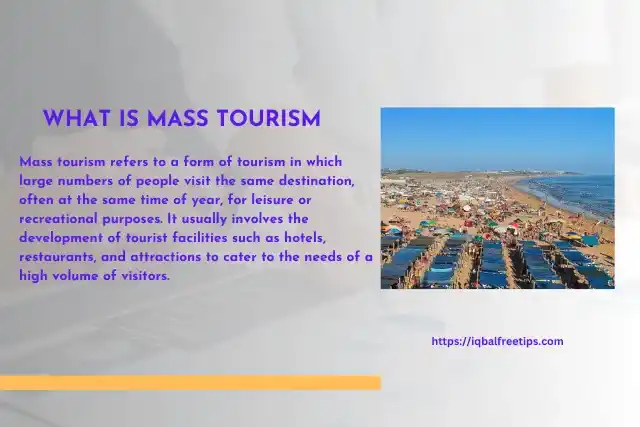
What is Mass Tourism?
Tourism is a major contributor to the global economy, and it plays a significant role in promoting cultural exchange, economic development, and international cooperation. Mass tourism, in particular, involves large numbers of people traveling to the same destination for leisure or recreational purposes. While it has some negative impacts on the environment and local communities, it also has several advantages, such as boosting the local economy, creating job opportunities, and promoting cultural exchange. In this article, we will explore the characteristics of mass tourism, its advantages and disadvantages, and the different types of tourism it encompasses.
Mass Tourism
Mass tourism refers to a form of tourism in which large numbers of people visit the same destination, often at the same time of year, for leisure or recreational purposes. It usually involves the development of tourist facilities such as hotels, restaurants, and attractions to cater to the needs of a high volume of visitors.
Characteristics of mass tourism
Mass tourism typically involves standardized, packaged tours that are marketed to a wide audience, often through travel agents or online booking platforms. The focus is on providing a low-cost, convenient, and hassle-free travel experience, with little regard for the environmental or social impact of tourism on the local community.
-
Seasonality
Mass tourism is often characterized by a high concentration of visitors during specific times of the year, such as school holidays, weekends, or popular festivals. This can result in overcrowding and strain on local resources during peak season.
-
Standardization
Mass tourism packages are designed to appeal to a wide audience and are often standardized to provide a similar experience for all tourists. This can result in a lack of diversity and authenticity, as destinations are tailored to meet the needs and expectations of the mass market.
-
Concentration
Mass tourism is often focused on a few popular destinations, which can lead to overcrowding and strain on local resources. This can also result in a lack of economic diversification, as the tourism industry dominates the local economy.
-
Low-cost
Mass tourism packages are often marketed as affordable, low-cost options for travelers. This can make travel more accessible to a wider range of people, but it can also result in a lack of investment in infrastructure and sustainable tourism practices.
-
Environmental impact
Mass tourism can have a significant impact on the environment, as large numbers of visitors consume resources, generate waste, and contribute to climate change. This can result in environmental degradation and damage to natural habitats, which can have long-term consequences for local communities and the tourism industry itself.
Advantages of mass tourism
Mass tourism refers to a large number of people traveling to a particular destination, often at the same time. While mass tourism can have some negative impacts, it also has some advantages, including:
-
Boosts the local economy
Mass tourism can bring in a lot of money to the local economy. This is because when tourists visit a destination, they spend money on things like accommodations, food, transportation, and souvenirs. This money helps to create jobs and supports local businesses.
-
Provides job opportunities
Mass tourism can create job opportunities for people in the local community. As more tourists visit a destination, there is a need for people to work in hotels, restaurants, and other tourist-related businesses.
-
Increases cultural exchange
Mass tourism can facilitate cultural exchange between people from different parts of the world. Tourists can learn about local customs, traditions, and way of life. This may result in a deeper appreciation for and understanding of various cultures.
-
Supports infrastructure development
To accommodate large numbers of tourists, destinations often need to improve their infrastructure. This can include building new airports, roads, and other transportation systems. These improvements can benefit the local community long after the tourists have left.
-
Promotes environmental conservation
Mass tourism can encourage the conservation of natural resources and the environment. When destinations rely on tourism for their economy, there is a greater incentive to protect the environment and preserve natural resources for future generations.
-
Increases awareness and interest in a destination
When a destination becomes popular among tourists, it can attract more attention from people around the world. This increased awareness can lead to more investment, trade, and cultural exchange with other countries.
-
Supports preservation of historical and cultural sites
Mass tourism can provide financial support for the preservation of historical and cultural sites. This is because tourists are often willing to pay entrance fees to visit these sites, and the revenue generated can be used to maintain and improve them.
-
Creates opportunities for cultural events and festivals
Mass tourism can create opportunities for local communities to showcase their culture and traditions through events and festivals. This can lead to a greater appreciation and understanding of different cultures, and can also provide a boost to the local economy.
-
Fosters international friendships and relationships
Mass tourism can lead to the formation of friendships and relationships between people from different parts of the world. This can help to break down barriers and promote understanding between different cultures and nationalities.
-
Encourages investment and development
Mass tourism can encourage investment in a destination, which can lead to further development and improvements in infrastructure, amenities, and services. This can benefit both tourists and the local community, by making the destination more attractive and accessible to visitors.
Types of tourism
Tourism can be broadly categorized into different types based on the nature of the travel experience and the type of tourist it attracts. Here are some common types of mass tourism:
-
Sun and beach tourism
This type of mass tourism typically involves traveling to warm, sunny destinations with beaches, such as the Caribbean, Hawaii, or the Mediterranean. It attracts tourists who are looking for a relaxing vacation by the sea, with activities such as swimming, sunbathing, and water sports.
-
Cultural tourism
This type of mass tourism involves visiting destinations that are known for their cultural attractions, such as museums, historical sites, and cultural festivals. Examples of cultural tourism destinations include Paris, Rome, and Athens.
-
Adventure tourism
Adventure tourism involves traveling to destinations that offer adventure activities such as trekking, camping, bungee jumping, and rafting. Examples of adventure tourism destinations include New Zealand, Costa Rica, and Nepal.
-
Eco-tourism
This type of mass tourism involves traveling to destinations that have natural beauty and wildlife, with a focus on sustainability and conservation. Examples of ecotourism destinations include the Galapagos Islands, Costa Rica, and Borneo.
-
Health and wellness tourism
This type of mass tourism involves traveling to destinations that offer wellness services such as spas, yoga retreats, and health clinics. Examples of health and wellness tourism destinations include Bali, Thailand, and India.
-
Cruise tourism
This type of mass tourism involves traveling on a large ship that visits multiple destinations during the trip. Cruise tourism attracts tourists who are looking for a convenient and comfortable way to see different parts of the world. Examples of popular cruise tourism destinations include the Caribbean, Alaska, and the Mediterranean.
Conclusion
Mass tourism is a form of tourism in which large numbers of people visit the same destination, often at the same time, for leisure or recreational purposes. It is characterized by standardized, packaged tours that are marketed to a wide audience, often through travel agents or online booking platforms. Mass tourism can have negative impacts on the environment and local communities, but it also has several advantages, such as boosting the local economy, creating job opportunities, and promoting cultural exchange. Types of mass tourism include sun and beach tourism, cultural tourism, adventure tourism, and ecotourism.
You may like:
what is industrial tourism? and its imortance




